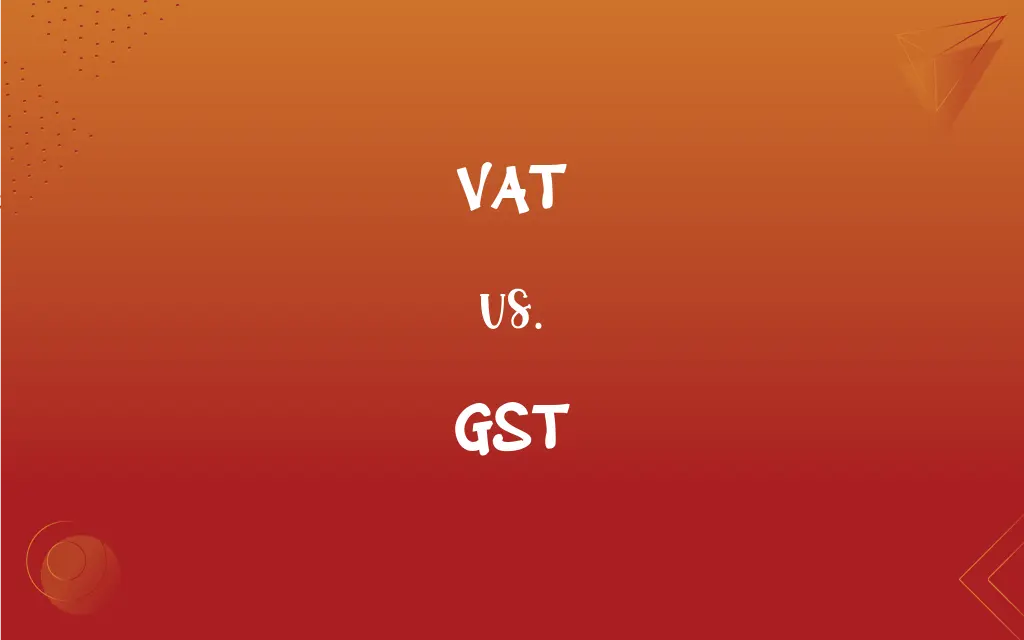VAT vs. GST: What's the Difference?
Edited by Janet White || By Harlon Moss || Published on November 30, 2023
VAT (Value Added Tax) is a consumption tax on the value added at each stage of production, while GST (Goods and Services Tax) is a comprehensive, destination-based tax on the consumption of goods and services.

Key Differences
Value Added Tax (VAT) and Goods and Services Tax (GST) are both types of indirect tax imposed on goods and services. VAT is typically charged at each stage of the supply chain, with businesses collecting and remitting the tax on behalf of the government. VAT is commonly used in European countries.
Goods and Services Tax (GST), on the other hand, is a unified tax that combines various indirect taxes into one. It's often destination-based, meaning it is collected in the place where the goods or services are consumed. Countries like Canada, Australia, and India have adopted GST.
While VAT focuses on taxing the value added at each stage of production or distribution, GST aims to consolidate multiple indirect taxes into a single tax. This makes GST broader in scope compared to VAT.
VAT can sometimes lead to cascading or "tax-on-tax" effects, though modern VAT systems are designed to minimize this. In contrast, GST is designed to eliminate the cascading effect by offering credits for taxes paid on inputs.
Despite their differences, both VAT and GST share the common goal of raising revenue efficiently while minimizing economic distortions. They are crucial components of modern tax systems worldwide.
ADVERTISEMENT
Comparison Chart
Full Form
Value Added Tax
Goods and Services Tax
Scope
Charged at each production/distribution stage
Unified, consolidates various indirect taxes
Tax Credit
Available, to prevent double taxation
Integral part, to avoid cascading effect
Implementation
Common in European countries
Adopted in countries like India, Canada, Australia
Tax Calculation Basis
Value added to goods/services
Consumption of goods/services
ADVERTISEMENT
VAT and GST Definitions
VAT
Tax System.
Businesses must calculate VAT on their products.
GST
Consumption Tax.
GST is charged at the point of sale.
VAT
Industrial Tank.
Dye is mixed in a vat at the textile factory.
GST
Unified Tax.
GST replaced several indirect taxes.
VAT
Fermentation Chamber.
Wine ferments in wooden vats.
GST
Tax on Goods/Services.
GST is included in the price of electronics.
VAT
Liquid Storage.
The vat holds thousands of liters of oil.
GST
Revenue System.
The government increased GST rates last year.
VAT
Large Container.
The brewery stores beer in a huge vat.
GST
Destination-Based Tax.
GST is paid where the goods are consumed.
VAT
A large vessel, such as a tub, cistern, or barrel, used to hold or store liquids.
VAT
To put into or treat in a vat.
FAQs
Can businesses reclaim VAT?
Yes, businesses can often reclaim VAT paid on business-related purchases.
Does VAT vary by country?
Yes, VAT rates and rules vary across different countries.
Is GST applicable to both goods and services?
Yes, GST is applicable to both goods and services.
What does VAT stand for?
VAT stands for Value Added Tax.
What is the main purpose of VAT?
VAT is imposed to tax the value added to goods and services.
What are the components of GST?
In some countries, GST has components like CGST, SGST, and IGST.
Does VAT apply to exports?
Generally, VAT is not applied to exported goods.
Is filing GST returns mandatory?
Yes, for businesses under the GST regime, filing returns is mandatory.
Is VAT a direct or indirect tax?
VAT is an indirect tax.
Does GST prevent tax cascading?
Yes, GST is designed to prevent tax cascading through input tax credits.
Is GST a global standard?
GST is adopted by many countries but not a global standard.
Can consumers reclaim GST?
No, consumers generally cannot reclaim GST.
Are VAT rates the same for all products?
No, VAT rates can differ based on product types.
Who collects VAT?
VAT is collected by businesses on behalf of the government.
Can VAT cause price increases?
Yes, VAT can lead to price increases for consumers.
Does GST simplify taxation?
GST aims to simplify the tax system by unifying multiple taxes.
Are there exemptions under VAT?
Yes, some goods and services can be exempt from VAT.
What does GST stand for?
GST stands for Goods and Services Tax.
How is GST different from VAT?
GST is a unified tax consolidating various indirect taxes, while VAT is charged on value addition.
Who pays GST?
GST is paid by the end consumer.
About Author
Written by
Harlon MossHarlon is a seasoned quality moderator and accomplished content writer for Difference Wiki. An alumnus of the prestigious University of California, he earned his degree in Computer Science. Leveraging his academic background, Harlon brings a meticulous and informed perspective to his work, ensuring content accuracy and excellence.
Edited by
Janet WhiteJanet White has been an esteemed writer and blogger for Difference Wiki. Holding a Master's degree in Science and Medical Journalism from the prestigious Boston University, she has consistently demonstrated her expertise and passion for her field. When she's not immersed in her work, Janet relishes her time exercising, delving into a good book, and cherishing moments with friends and family.































































